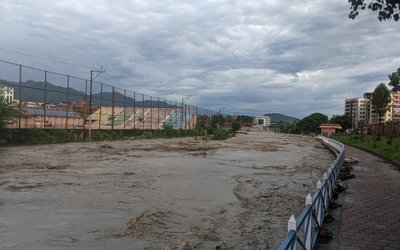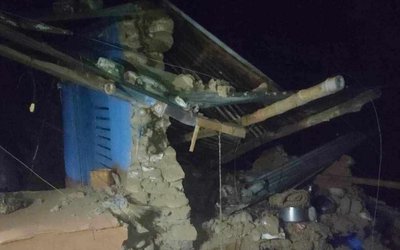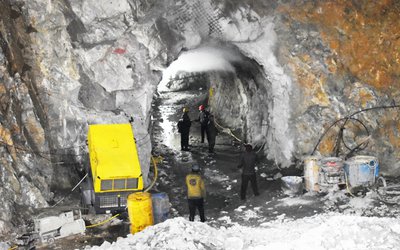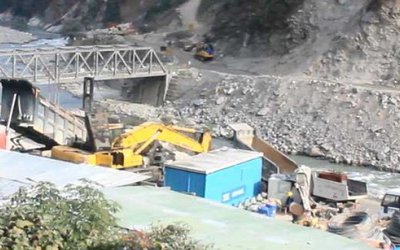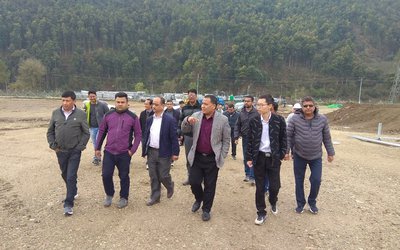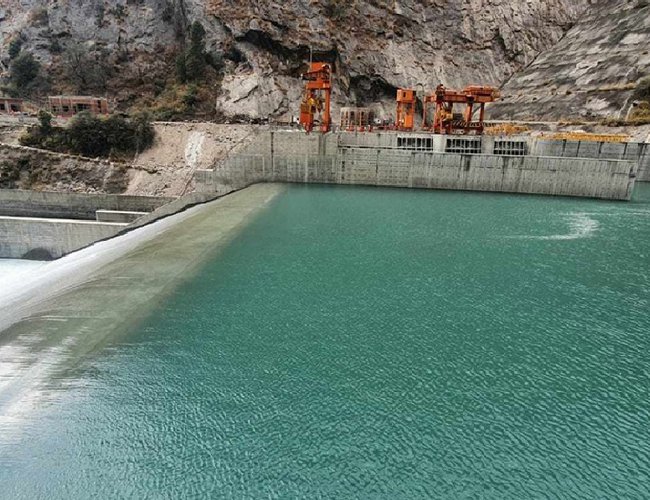
A dark shadow of sham patriotism in harnessing natural resources for hydropower looms over Nepal as it prepares for implementation of Energy Development Roadmap and Action Plan, 2023-2035, which envisions the export of 15,000 MW of surplus electricity to the neighboring countries of India and Bangladesh. Since the dry season of Nepal undergoes severe decline in hydropower production attributable to global climate change phenomena, especially the glacial retreat of our Himalayas, the power sector immune of the country cannot be considered good owing to the absence of its self-healing capacity. Around 600 MW of power deficit and, in terms of energy, around 40 percent of the daily electricity consumption of the country during these dry season months are fulfilled through import from India. Nepal’s present installed capacity tending to touch 3,000 MW, around 95 percent of which is hydro-based, has introduced energy insecurity in the country in terms of electricity suggesting the state and the private sector that they need to ramp up their efforts for more capacity addition in upcoming years. It clearly unfolds the reality that more resilience and extra efforts are to be exerted on the supply side to produce encouraging results for downsizing the quantum of power import from India during the lean-hydro season. Given that geopolitical dimensions are always inherent in some forms of the bilateral system between any two countries, the reason being that absolute diplomacy doesn’t exist anywhere in the world, Nepal should strategize itself in terms of energy security as a critical component of national security to overcome the ongoing setbacks in our demand-supply chain of power before they emerge as major upheavals to destabilize overall economic performance of the country. We should rejoice the accomplishment of the private sector in hydropower production in the country since the Electricity Act 1992 and the subsequent Hydropower Development Policy 2001 invited and encouraged private sector, both domestic and foreign, to come into the hydropower industry. It made a visible difference to the sector though the stride was not completely bereft of turbulences in various realms such as policy fragility, fund crunch and infrastructure constraints. We should admire and recognize the accomplishment of the private sector and encourage them to be further ready to embark on the next chapter of their journey for their increased participation in larger scale hydropower projects for promoting self-reliance in electricity.
Nepal also needs to fast-forward its pace of hydropower generation to accelerate the nation’s net zero agenda with 2045 as the benchmark year for achieving the same. It means that we need ample hydropower generation to achieve twin objectives of ensuring energy security and energy transition. We can’t have leverage to spend a longer time in this activity because we all know that the impact of climate change is already knocking at the door and our hydropower resources are highly vulnerable to it. Furthermore, other renewable energy sources and technologies may outperform hydropower in both cost and time in future. With the advancement in technologies and other innovative measures including, inter alia, labor economy, efficient process and decrease in material costs, the price of solar electricity is poised to continue precipitous drop, whereas its variability leading to output fluctuations and possible grid outages may be fairly supplemented by pairing it with battery storage system, for which the world is striving hard to make it financially feasible in future.
Government of India has already embarked the supportive initiative for installing battery energy storage systems to fight intermittencies caused by excessive integration of solar and wind power into its grid by invoking financial instruments such as concessional green finance accessed by itself and the viability gap funding up to 40 percent of the capital cost of the project, with the condition that the project must be commissioned within 18 to 24 months. Towards this end, it has already issued National Framework for Promoting Energy Storage Systems.
However, it is deplorable to note that Nepal has not declared energy (electricity) crisis in the country in spite of our dependence on the Indian market by about 40 percent of our daily electricity consumption in its dry season. If so, the legislature could pass sunset laws to be enforced by the Government so that less bureaucracy and fast-tracked decisions would accelerate the power sector activities until the crisis prevails and some laws, particularly pertaining to forest clearance and land acquisition – thought to be more burdensome and time-consuming, could be replaced by simplified procedures or exceptional rules by adopting the temporary suspension of those laws or rules which create obstacles in expeditious development of hydropower projects or transmission infrastructures within a stipulated time. At this moment, besides solar power promotion, at least, Government may create favorable environment for those hydropower projects which have already entered into implementation phase through necessary, positive interventions required to fast-commission the projects and it may even call for the steps up to the extension of Required Commercial Operation Date (RCOD) stipulated in the power purchase agreements since they may trigger penalty provisions to the projects. Financing agencies are reluctant to make disbursement of funds to them in case RCOD is not extended, further slowing town the projects without required funds on time.
However, it is irony that more installed capacity of hydropower plants added to address the energy portfolio of the lean-hydro season means that it also leads to a difficult situation having to cope with extra power surplus in the country during the high-hydro season. We can visualize the installed capacity effect on the surplus front in Nepal’s context through the lens of an operational power plant, say, Upper Tamakoshi Hydroelectric Project, Peaking Run-of-River by scheme, which is the largest capacity plant in Nepal with the units of total 456 MW installed capacity. The seasonal impact has so drastically diminished its operational performance that the present output in the last week of March is just 50 to 65 MW on average and, energy wise, it may, upon estimation, meet only about 65 percent of the monthly contract energy as tabulated in the Power Purchase Agreement during the ongoing Nepali month of Chaitra and this energy output will be about 11 percent less than that in the corresponding month of the previous year. Interestingly, this figure of 11 percent exactly matches with the Government of India’s report that about 11 percent fall of hydro generation in India was recorded in the first half of the fiscal year 2023-24. It speaks of the truth that Nepal’s hydropower generation and consumption pattern urges us to cope with two contradictory situations in a same year - power surplus during wet season requiring cross-border market for power export and power deficit during dry season requiring power import from the neighboring countries.
Now-a-days, many sections of the Nepalese society seem to perceive that Nepal has already become a power surplus country and it is doing a great charity or beneficence to India by the act of exporting green power to India. It’s merely a wrong perception. India’s power system is so terrifically immense in comparison to ours that its peak demand met in the past is about two lakh forty thousand Megawatts, which is expected to reach up to two lakh fifty thousand Megawatts in the period from April to June, 2024, as per an advisory issued recently by Government of India to all generation companies including Independent Power Producers for timely import of coal for blending purposes and maximizing production in captive coal mines. If the share of the quantum of power, 690 MW, likely to be exported during the wet season from Nepal to India based on the project wise approval of Government of India received so far is calculated, it is just around 0.29 % of India’s peak demand. It is, of course, just a drop in the ocean. However, it is so big for us that had we not been able to export this power to India in the last wet season months, we would have lost the energy revenue of around 15 billion Nepali Rupees, thereby issuing non-dispatch orders to the power generators and spilling the valuable water in rivers in vain. That is why cross border power trading should be considered as mutually beneficial act meant for fostering power sector cooperation between the countries.
Power export to India has been pilloried by some so-called ultra-patriotists in Nepal. They advocate that electricity should be solely consumed inside our country and it should not be exported at all. However, in Nepal’s case, until Nepal enters into round-the-year power surplus, the present situation of seasonal surplus and seasonal deficit in homegrown power will continue to exist for at least 4-5 years, if everything goes well. Currently, only the generation projects of around 3,500 MW, mostly from the private sector and hydropower, are under construction after achieving the financial closure, whereas generation projects of around 3,700 MW have been seemingly loitering in search of funds or implementing agencies. At any situations, when Nepal strives to increase its hydro-installed capacity considering its dry season deficit, system produces more and more surplus power which makes power export inevitable. If it remains unsold in the external market, the story does not end there. It will be followed by finical upheavals and its waves will destroy the environment of further hydropower development. First, it will shatter NEA’s financial status since it, as an off-taker, has signed long-term Take-or-Pay basis PPAs with IPPs. Second, a struggle for IPPs’ survival awaits when NEA reaches a climax of financial hardship to make payments. Third, a bleak picture surrounds the banks and other financial institutions which will be deprived of loan-and-interest payments. Fourth, country’s whole economy will start sweating in havoc because hydropower projects are highly capital-intensive industries and socio-economic agitations and cascading effect will lie in the avalanche of widespread social agitations because many people have bought shares of hydropower projects with the reckoning that they all lay gold eggs. It is not important to consider who speaks what, but the reality is that electricity is a product and all products need market. When our domestic market of electricity is small and limited and cannot grow overnight, we must sell our product in the external market. Simple economics is enough to understand it; no advanced calculus is required to explain the same. Hence cross border power trading is of paramount importance through several perspectives including energy security, energy transition and economic prosperity.
However, a dark side of geopolitics looms over South Asia as we are moving forward for seamless power trading in the region. This geopolitics introduces strategic interpretation of electricity and its trans-boundary trading. Hydropower is harnessed from water resources where national interests may not always coincide, especially when trans-boundary water governance issues arise. Then, bilateral cooperation becomes difficult because of the proclivity of the countries for their national interests. Such trans-boundary river issues, national security concerns, border disputes and political differences, inter alia, have been eroding the prospects of cooperation in power sector and that is why South Asia, despite being rich in diverse natural resources, has continued to be one of the least integrated regions in the world. Coming closer, in the BBIN sub-region itself, geopoliticalinstincts are hovering over cross-border power trading between India and the neighboring countries. Indian policies have targeted Chinese-owned or controlled hydropower projects in Nepal to repel the Chinese investors from the sector by restricting the purchase of electricity by India from such projects, without naming China but still giving a clear message to a third country, land-bordered to India and yet not having a bilateral agreement on power sector cooperation with her. If it doesn’t sound appealing, relaxation to it is couched in the provisions by means of consultation by the Designated Authority of India with Ministry of Power and Ministry of External Affairs, thereby providing a silver lining which may be activated in Nepal’s context through proper diplomacy, mutually beneficial cooperation and impactful dialogues with India.
In the ongoing geopolitics in this part of Asia, China-India tension, of course, is a prime factor for determining peace and stability in general and advancing economic agenda in particular. Since India feels security challenge from China in the light of animosity which welled up since 1962 China-India war, India continues to consider China as a potential threat. Dr. Ivan Lidarev, a foreign policy analyst and expert on Asia security, while writing for The Diplomat, has pointed out in his article that the 1962 war represented an important watershed in India’s foreign and security policy. Against this backdrop, also having agreed with the situation that many Chinese developers have been involved in the development of different hydropower projects in Nepal, we are to bound to understand India’s reluctance to consider all land-bordered countries equally while framing its eligibility criteria to import power from the neighboring countries.
However, there is room for positive thought that that Nepal can look forward to signing power sector cooperation agreement, except three existing MOUs, one day between China and India since some sort of treaties or agreements on the trans-boundary rivers like Brahmaputra, Indus and Sutlej, though it’s our wish only, could help ameliorate their water conflict. Along with India’s ambitious initiative of ‘One Sun One World One Grid’, we can also hope that China will be joining the International Solar Alliance one day as India’s Minister for Power and Renewable Energy, Mr. R. K. Singh, stated that China was welcome to be part of the Alliance, as the membership of the 116-country compact was open to all. On top of that, as an option stated in India’s own power import/export procedures, Nepal can also skip the eligibility criteria for power import by India from the power plants located in the neighboring countries by politically and diplomatically convincing India that Nepal deserves the relaxation of the restrictive provision for various reasons including river-based treaties, power trading agreements and, over all, centuries-old friendly relations which are well understandable to both countries.
In this context, India’s External Affairs Minister Dr. S. Jaishanker’s opinion expressed on a recent podcast with Saurav Dwivedi, an Indian journalist, looks brilliant. He has emphasized the need for creation of permanent collaboration between the countries to prevail over politics which will go up and down in neighborhood and, he thinks, that is part of how politics takes place. His words-we need to find solution beyond politics – are quite relevant in our context since it will underpin the relevance of beyond-politics solution in fostering broader economic outcomes through mutually- beneficial energy partnership between Nepal and India. Yes, Nepal’s hydropower will be valuable to India in its mission toward clean energy transition and decarbonization of the economy. Likewise, Nepal should keep in mind that cross border power trading with India has garnered significant benefits to Nepal also, especially in alleviating power cuts during the dry season months and exporting surplus power after meeting domestic demand of the country during the wet season months for making money of it, which will further grow in future vis-à-vis Nepal-India long-term power trade agreement carrying ten-thousand-Megawatt milestone. This is called cooperation which should go on without interruption. In cooperation, there is no need to abandon national interests, but still both sides can win through a trust-building process.
Adhikari is an Energy Expert and the former Deputy Managing Director of Nepal Electricity Authority. He can be reached at prabaladhikary@gmail.com

